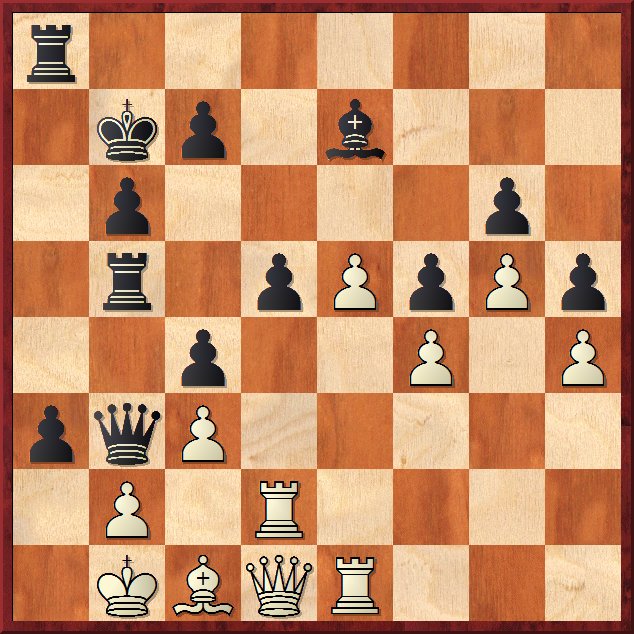 Braunstone Chess Club
Braunstone Chess Club
| Team Results |
| Fixtures & Results |
| Gradings |
| Club Championship |
| Juniors |
| Useful Links |
| Club Library |
| Games |
| Archive |
| Trophy Cabinet |
| Puzzles |
 Click on the salisbury v morley link to see an interesting game played by your webmaster against the county champion Andy Morley where I was completely winning (but obsessed with winning black's queen) to totally losing, but due to Andy's time shortage a draw was agreed as Andy I think felt sorry for me!
Click on the salisbury v morley link to see an interesting game played by your webmaster against the county champion Andy Morley where I was completely winning (but obsessed with winning black's queen) to totally losing, but due to Andy's time shortage a draw was agreed as Andy I think felt sorry for me!
The following game was played in the 2009 County Championship between two Braunstone club players, Mike Salisbury and Paul Colburn. It is put on here at Paul's request (or should that be insistence) as it has a "puzzle type" mate in 4 at the end. It is certainly not a game I (MWS) would choose to publicise, with less than flattering (although accurate) remarks about my play.
Mike Salisbury 0 – 1 Paul Colburn played 30.04.2009
Analysis by Fritz & Paul Colburn
B02: Alekhine's Defence: Chase Variation and lines with early Nc3
1.e4 Nf6 2.e5 Nd5 3.Bc4 Nb6 4.Bb3 d5 (my opponent told me afterwards that he had intended to play something different 2. Nc3 instead we have transposed into a Caro-Kann type position) 5.d4 Bf5 6.g4 Bg6 7.h4 h5 8.g5 Qd7 9.Nh3 Bf5 10.Nf4 g6 11.Nd2 Nc6 12.Nf1 Bg7 13.Ne3 0–0–0 14.c3 (14. Ned5 doesn’t win a pawn as play either goes Nd5 15. Bd5 e6 when black regains the pawn and opens the position for his bishops or 15. Nd5 when Be4 collects a piece) Be6 15.Qd3 Rhg8 16.Bd2 Bh8 (I didn’t mind wasting a tempo on the bishop move to try and block up the kingside and the g6 pawn needs protecting) 17.0–0–0 Na5 18.Nxe6 Qxe6 19.f4 f5 20.Kb1 (To be honest the game had not gone as planned upto here and White has a strong position but this was the start of the transformation of the game with the kingside blocked I now focussed on an attack on the queenside whilst my opponent seemed to drift along without any real plan) 21...Rd7 21.Rh2 Rgd8 22.Nc2 Nac4 (At this point Fritz would rather I swapped off the Knight for the Bishop but I felt that this would give the play to White. As he has an open file to attack down and can prepare c4 when he can favourably open up the position whilst all I can do is sit and wait) 23.Be3 a5 24.a3 Bg7 25.Bg1 Bf8 (I am in no hurry I intend to slowly improve my position and put pressure on that a pawn whilst I felt my opponent was just aimlessly moving pieces around)26.Ne3 Nxe3 27.Bxe3 Qc6 28.Rc2 Nc4 29.Qe2 e6 30.Bxc4 (A mistake as this now means my rooks can enter the attack 30 Ka1 would have left the position level with no real way of breaking through) 30...dxc4 31.Qg2 Rd5 32.Bc1 Qb6 (Qa4 would have better for me) 33.Ka1 Qb3 34.Qe2 Rb5–+ 35.Be3? Bxa3! (The White bishop needed to move to stop 35... Ba3 36 ba3 Qb1# but it should not have moved here, 35. Bd2 was necessary. My Bishop cannot be taken in light of line 36 ba3 Qa3+ 37. Ra2 Qc3+ 38. Rb2 Rb2 39. Qb2 Qe3 when Black is three pawns up and should soon win) 36.Bc1?! Be7 37.Rcd2 a4 38.d5 (hopeless but what else can be done?)38...exd5 39.Qe3 b6 40.Re1 a3 41.Qe2 Kb7 42.Qd1 Ra8 (Here my opponent actually resigned but had continued as planned with 43. Kb1 how does Black force mate in four?) 43.Kb1
Black to mate in four:
